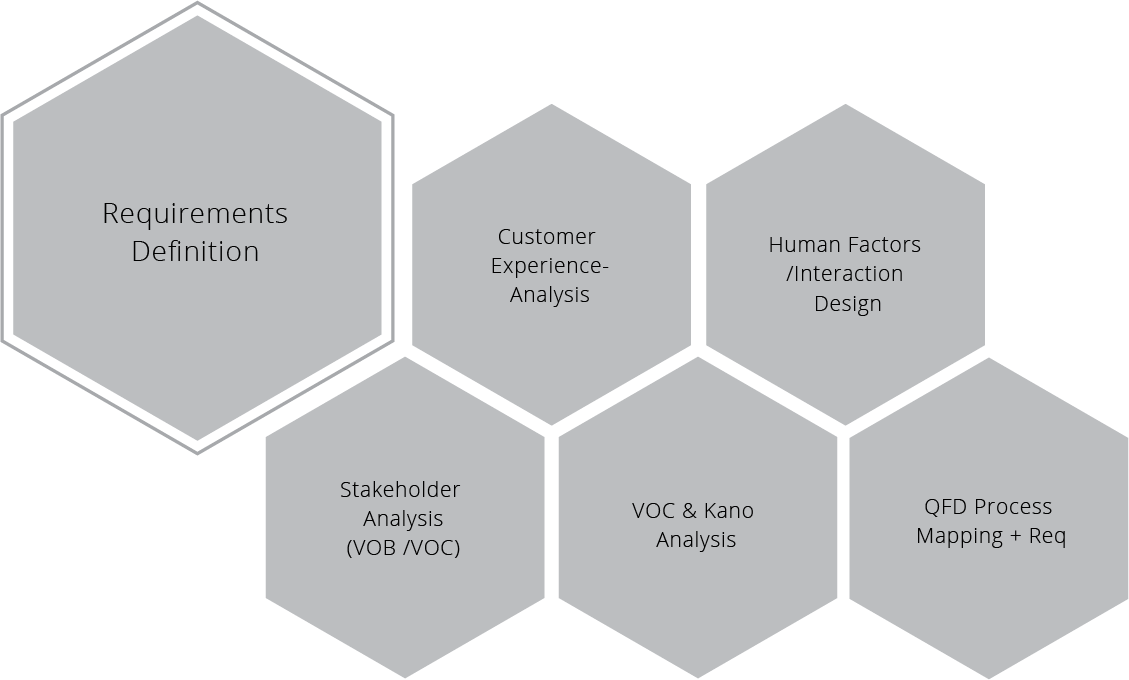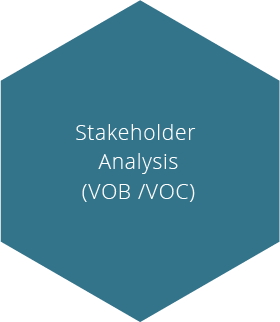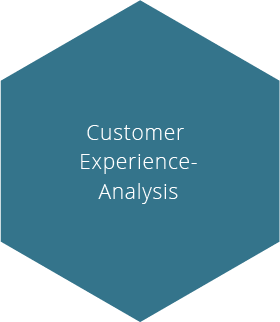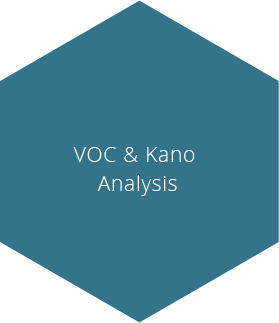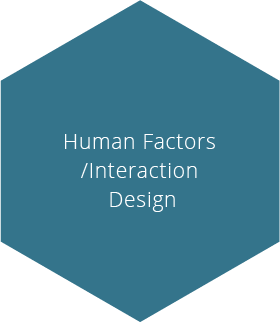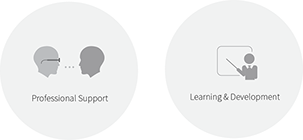Glossary
Logout
©Copyright Arcturus 2022, All Rights Reserved.
7
Terms & Conditions
|
|
|
|
Security & Privacy
Contact
QFD PROCESS MAPPING + REQ.
|Introduction

Quality Function Deployment (QFD) was introduced more than thirty years ago in Japan as a quality system focused on delivering products and services that satisfy customers. To efficiently deliver value to customers, it is necessary to listen to the "voice" of the customer throughout the product or service development process. The late Dr. Shigeru Mizimo, Dr. Yoji Akao, and other quality experts in Japan developed the tools and techniques of QFD and organised them into a comprehensive system to assure quality and customer satisfaction in new products and services.
Since 1983, companies have discovered this powerful approach and are using it with cross‐functional teams and concurrent engineering to improve their products and services, as well as the design and development process itself.
Quality Function Deployment... a definition
Quality Function Deployment is a customer‐oriented approach to product and service innovation. It guides managers through the conceptualisation, creation, and realisation of new products and services. The QFD process encourages you to gain an in‐depth understanding of the requirements of your customers needs and wants thus enabling you to prioritise the features/benefits of your product/service to these requirements.
The QFD process starts by listing customer requirements, in the customer language, it then systematically translates these requirements into appropriate ‘design’ characteristics and measures. The methodology includes the use of “a set of planning and communication routines that focuses and co‐ordinates skills within an organisation. In short, QFD helps you identify objectives that reflect the needs of real customers. Identifying objectives from a customer point of view ensures that customer value is created in the phases of the innovation process that follow conceptualisation. QFD embodies an evolutionary approach to product / service innovation: conceptualising your products by carefully evaluating, from market and customer perspectives, the performances of preceding products. QFD is in fact a method for continuous improvement, emphasising the impact of innovation on organisational learning. QFD makes it possible to incorporate the multi‐disciplinary communication and decision‐making processes into the organisation: it brings disciplines together.
The objectives of Quality Function Deployment...
In general, QFD helps you focus your development efforts in order to achieve objectives that will create value for your customers. So, QFD keeps you from designing products or services for which your customers have neither need nor use. Below, is a list of the objectives that QFD will help you reach.
Focus on the customer
Many new products and services fail because of a lack of customer focus QFD helps the organisation to focus on the customer. It provides a careful routine to incorporate both customer and market (competition) perspectives into the conceptualisation phase of the innovation process. QFD forces you to aim your innovation efforts at real customers instead of an impersonal market. Furthermore, the QFD approach facilitates a shared interpretation of customer needs (“Whats”) within the project team, and provides a process to translate these needs into measurable requirements (“Hows”).
Reduce time‐to‐market
False assessments of technical feasibility are reflected in the number and scope of design changes we have to make after design release. These design changes directly affect the possibility of reaching our time‐to‐market targets. Often, they occur because the concept of the new product was not studied with enough critical sense. Due to the sequential structure of our product innovation process, we tend to postpone decisions on issues like manufacturability to later phases, when they may present us with problems that have a much greater impact. What we should do is take the lead in the prevention of problems. This can be achieved in two ways: by managing the level of uncertainty and managing the scope of change. QFD supports both. It is a multidisciplinary team approach that brings together all available knowledge and pinpoints the unknown. QFD helps you
select those and only those technical objectives that will maximise customer benefit, given particular time and cost windows.
Reduce cost
QFD supports the identification of the product characteristics that the customer thinks are less important. High performances with respect to these characteristics, compared to those of competing products, provide opportunities for cost reduction.
Manage information
Many product concepts suffer from an information overload. In most cases, the required knowledge is available, but it is difficult to distinguish between relevant and irrelevant pieces of information, data, and opinions, and to cluster these into a manageable format. Information overload conceals the information that you do not have. QFD activates the knowledge that is available in the organisation and helps you structure all relevant information and experiences.
Improve marketing and development collaboration
To a large extent, product innovation productivity is determined by the way in which marketing and development people work together in the initial phases of the product innovation process. Often, the level of this collaboration leaves room for improvement. We have seen too many cases in which either marketing defines the new product’s specifications and has development try to realise them, or development creates all kinds of options from which marketing makes a selection for the new product. Both approaches involve a significant loss of development effort. QFD provides a format for both marketing and the development team to contribute and share their knowledge. QFD serves as a communication aid between these two perspectives on the new product or service.
Organisational learning
Sometimes product innovation is a shot in the dark. In the event of failure, this trial‐and‐error approach is so loaded with emotions, that it cannot be used as a stepping stone for learning. In such cases, it is impossible to reveal the incorrect assumptions that have ruled the design‐decision‐ making process. Assumptions have not been formulated explicitly. Therefore, we should periodically check the assumptions from which we conceptualise our new products. In QFD, assumptions about customer preferences and design decisions are well documented. Subsequent QFD application provides a highly valuable set of verified assumptions about customer requirements and how they relate to technical issues. As such, QFD lays a basis for organisational learning.
Modern Quality Systems
QFD is quite different from traditional quality systems, which aim at minimizing negative quality (such as poor service, inconsistency). With those systems, the best you can get is nothing wrong ‐ which we see is not enough when all the players are good. In addition to eliminating poor service, we must also maximize positive quality (such as fun, luxury). This in turn creates value and competitive advantage.
Quality Function Deployment (QFD) is a comprehensive quality system aimed specifically at satisfying the customer. It concentrates on maximizing customer satisfaction (positive quality) ‐ measured by metrics, such as return business and compliments. QFD focuses on delivering value by seeking out both spoken and unspoken needs, translating these into actionable services, and communicating this throughout the organisation. Further, QFD allows customers to prioritise their requirements, tells us how we are doing compared to our competitors, and then directs us to optimise those aspects of our service that will bring the greatest competitive advantage. What business can afford to waste limited financial, time and human resources on services customers don't want or where we are already the clear leader?
Types of Requirements
To satisfy customers, we must understand how meeting their requirements effects satisfaction. There are three types of customer requirements to consider...
Application area of QFD
Faced with the increased competition and the quickening pace of technological change and market needs many of our companies have adopted formal management systems in order to plan and review the product development activities. In general, these management systems outline the development process step by step, including the points at which go‐or‐no‐go decisions are made and the requirements for intermediate results. These procedures, however, do not describe how to organise the conception and planning phase. Yet, this phase is very important because in it, by intention or default, we link new product characteristics to target groups and their requirements. Of all the steps in the development process, none deserves more and receives less attention than the definition of the right product. Typically, it is in this phase that the QFD process starts by supporting the design team in formulating and communicating assumptions explicitly. Furthermore, the QFD‐ methodology can be applied at each downstream stage where you need to make a precise translation. For instance, to translate product specifications into component characteristics, component characteristics into process characteristics or process characteristics into production requirements.
Preparing for QFD
QFD is designed to be a multidisciplinary team activity. The following conditions, steps, and suggestions will increase the success of your QFD project.
Management assignment
Before any initiatives are taken it should be clear who requested the study, what the topic and the objectives of the study are, and how much funding will be available.
Organising for QFD
Appoint a project leader
The team leader serves as a mediator between management and the team members. The team leader is preferably a product manager and/or senior product engineer. The team leader’s main responsibility is to keep the team going within the scope and time frames that have been set.
Appoint a QFD facilitator
The QFD facilitator could be anyone who is familiar with QFD methodology. He should know the main steps of the process and be skilled in the application of QFD tools. It is the responsibility of the QFD facilitator to ensure that the exercise is completed in the most efficient manner
The QFD facilitator
Explains the QFD method, so all QFD team members know what is expected; Ensures that a consensus is reached in good time;
Ensures co‐operation inside and outside of the sessions.
In general, the role of the facilitator is to improve communication, teamwork, and documentation. The facilitator needs to maintain a close relationship with the team leader. Facilitation of QFD in a pilot application could be provided by an external consultant.
Appoint the QFD team
Together with the project leader, management should decide who should be on the team to build the initial House of Quality. The team will generally consist of representatives from product management, consumer/customer research, product development and manufacturing. The teams should preferably consist of approximately five to seven people. Depending on the object and scope of the study, the composition of the team may diverge from this general set‐up. With the downward transfer of the objects of study, the team members will change.
Prepare for the initial QFD team meeting
Prior to the initial QFD team meeting the project leader and facilitator should meet in order to:
- Define the scope of the project;
- Outline the QFD process, set a clear path for the QFD team, including time frames for the intermediate results that have been cleared with management;
- Establish the format of the team meetings and determine the length of the sessions; Prepare the initial scope explaining what is to be accomplished and what is needed for the project to succeed.
The initial QFD team meeting
The initial QFD team meeting is to accomplish two things:
- First to learn the scope of the project;
- To learn the main structure of the QFD process.
First of all, the scope of the project must be clearly defined, understood and agreed upon by all team members. This helps to avoid the question “Why are we here?” which will inevitably arise whenever the scope is poorly understood. Understanding the scope as well as management expectations helps the team members establish priorities. Before embarking on the QFD study, the team members should reach agreement on such issues as:
Key questions:
- Which products are we going to improve?
- Do we focus on a specific characteristic of the product?
- For what market or segment [target group(s)] are we aiming and who, in fact, do we consider as our customers?
- What are the planning and time frames of the project?
- How does the QFD study fit into product planning?
- Which competing products will be used as a reference for product evaluation?
During the initial team meeting, the facilitator needs to ensure that everyone understands the structure of the QFD process. Thus, the team will get an idea of the amount of effort and information that will be necessary to complete the task. The results of this meeting should be communicated to and agreed upon by management.
An introductory QFD‐project is the first step in the continuous process of improving product or service development productivity. After a number of projects, QFD should be completely incorporated into the standard product development activities. In order to turn the pilot project into a success, the project leader, the QFD facilitator, and the manager should reach an agreement on:
- The duration of the project;
- The time frames for the various intermediate results;
- Resource inputs (time investments by team members and costs of additional investigations);
- The reporting structure
A QFD project will require several meetings, which are used to co‐ordinate activities and update matrices and charts. As part of the project, team members will also spend time working on individual assignments. Reporting should focus on what information has been used, what information is needed, and difficulties in getting that information. The reporting structure will depend on the frequency of the team meetings and the group dynamics. Experience shows that if the team leader reports to the manager on a monthly basis, there will be enough time to measure progress. Finally, the product manager needs to show continuing support for the team after the project has started.
The product manager should inform all other managers of the QFD project, its scope, its objectives, and the names of the team members. This helps to eliminate problems when team members are asked to do more than they can. Remember that a QFD experiment is not a part of just another product development project, but it is an attempt to improve the way in which you develop products.
After each session, the QFD‐facilitator and the team leader should review the outcome of the meeting, prepare the strategy for the next meeting, and recommend methods for gathering additional information based on the data received. There are some key points the team members should remember:
The process may seem relatively easy, but it will require significant effort; many entries may seem obvious, but they do so only after they have been written down;
The charts may appear to be the main objective, but they are only the means in order to achieve the objective, which is: to have the customer’s voice reflected in design decisions.
Product renewal involves the implementation of a change of product and process characteristics on the basis of customer requirements. Therefore, these customer requirements need to be translated downstream into design requirements and furthermore into components, process and manufacturing requirements.
QFD provides the general means to make these downstream translations. We have found that the QFD process is most beneficial in the first phase (translating customer requirements into design requirements). Therefore, in this manual we will describe the steps that constitute the QFD process in this initial phase. In terms of method, the application of QFD for the other translations is almost identical.
We have already presented the required preconditions for a successful QFD application: the scope of the study should be clear. Translation of customer requirements into design requirements is not a one‐to‐one translation, however. One customer requirement can be related to more than one design requirement, and a design requirement can influence several customer requirements. QFD therefore uses a matrix. This matrix of QFD is called the “House of Quality”.
List the Customer Requirements...
First of all, the QFD team asks itself: Who is the customer? If we do not know the customer, we do not know his wishes and requirements. This question often gives rise to heated discussions, due to the fact that there are various perspectives from which this question can be answered. It is of vital importance to the QFD process that a consensus is reached within the QFD team about the kind of customer to focus on. If we cannot agree on the target customer, this discussion will be repeated regularly, thus causing team member confusion and reduced team productivity. We need to have a clear customer profile. A good description includes the end‐users, but could also include a profile of the persons who buy the product and perhaps the dealer who influences the potential buyer in his/her purchase decision. Even a Consumers’ Association could have a place in this description, because they provide potential buyers with overviews of the results of product evaluations.
Know expressed, implicit, and attraction requirements
Suppose that we know our customer and ask him about his requirements for the product. The wishes and requirements he will then give us, we call expressed requirements. The more of these requirements he will find fulfilled in our new product, the more he will feel inclined to buy it. Apart from these expressed requirements, we must also consider the customer’s implicit requirements. These are the requirements which are not expressed by the customer, but which he assumes to be present. Implicit requirements refer to the dissatisfies in products (i.e. safety, risk and reliability). ...we must generate these requirements ourselves. Finally, the attraction requirements are neither expressed nor expected by the customer, but when he notices them, he will be surprised and excited. Attraction requirements refer to the satisfiers in a product. These requirements are of the utmost importance in attracting the attention of customers and getting the product sold.
Kano Model
Customer Focus...
Customer Focus...
The above can also be represented as follows;
Paired Questions
Collect customer information
If we choose to improve a current product, then we already know a lot about the customers. If we take a completely new product, this will be more difficult. It is quite possible that we know the customer for a new product fairly well, but the product is too new to ask him about his requirements. In this case a good customer profile can help to estimate what is important, less important or not important to him. To collect information about the requirements of the customers you could use current data collection methods. Here are some suggestions:
- First you could ask the customer. In this case we have to know the customer, and if there are different kinds of customers, we have to know the target groups. Problems: customers must be willing to answer your questions; you will only get the expressed requirements.
- You could also observe the behaviour of customers while they are using or buying the product; for instance, at exhibitions, in department stores (you could play the role of a part‐ time dealer) or in real‐usage situations: how they try to use the product, which functions they compare, which questions they ask. Problems: it is time‐consuming.
- Enlist the help of an internal or external customer research agency. See ‘Market Research and Intelligence’ element.
- Generate the list of requirements yourself. Time does not always allow you to do extensive customer research. In this case, we can only use information and knowledge about the customer that is directly available. We have to exploit our empathic skills to imagine what the customers needs are.
Draw up the list of customer requirements
Customer requirements are characteristics that customers explicitly or implicitly attribute to the new product. These requirements should be expressed in “customer language”. In the case of a consumer product, this means that we avoid using technical terms. In an industrial customer‐ supplier relationship, however, customers are in fact often able to express their needs in terms of technical product characteristics. In general, we can say that customer requirements should be expressed in a language that is meaningful to the customer. The list of customer requirements is called the “WHATs” list, and it reflects what is important for the customers on whom we focus.
The meaning of the customer requirements needs to be worked out in order to gain a collective understanding. Customer requirements can be separated into two or three levels. More detail is not necessary, because it would make the list too complex to use easily. For this step, QFD uses a tree diagram. In this way, we describe the requirements in more detail in order to be able to make better judgements when comparing current product performances. To check whether the list is complete and carries enough detail you should ask yourself:
- Do all members of the QFD team understand the meaning of each item?
- Is the list sufficient to make a competitors’ analysis?
- Is the list sufficient to make judgements about the importance of each item to the
customer?
Pre‐requisite Market Information
It is vital to the success of the project that the all members of the QFD team understand the product / service target market. It is therefore the responsibility of the Product Manager to prepare a suitable brief to include the proposed target market, together with primary and ring fenced parameters (Target Costs, Product Positioning, Product Price etc.).
Without a clear and well understood brief, questions regarding the market and the project mandatory’s will be repeatedly asked ad nauseam.
Stakeholder Analysis
Traditionally, the QFD team consists of members of the cross functional units from within the company ~ multidisciplinary team. The QFD team can be expanded to include important stakeholders ~ Customers, users and decision makers...
Step 1 Identify all Stakeholders and rate their importance and impact.
Step 2 Identify the major stakeholders that can affect the competitiveness of the project and include them in the QFD team.
Step 3 Identify stakeholders' requirements ~ VOC and VOB.
Step 4 Develop a list of design requirements to satisfy stakeholder requirements.
Step 5 Establish a dialog with the stakeholder teams.
Step 6 Benchmark companies performance on the stakeholders' requirements and technical targets against those of your
competitors.
Step 7 Identify areas for improvement and work with stakeholders to develop a sustained plan.
Step 8 Develop a long‐term association with stakeholders.
Step 9 Conduct a stakeholder audit to determine when to add new stakeholders and when to remove inactive ones.
Identify the stakeholders and their courses of action
It is important to know who your stakeholders are just as it is important to know who your customers are. A comprehensive list of these stakeholders will be a beginning point as well as their courses of action. For example, how influential are these stakeholder teams? Are they likely to influence the customer perception of the product and the firm? Remember that in marketing, you do not want any negative ads. Stakeholder teams that are able to reach a wider audience and that have a track record of being on the right sides of the issue can not only influence potential customers but also legislators to enact new laws that may affect the performance of the firm. These stakeholder teams should be treated as active participants and integrated in the product planning and design stages. The list of stakeholders generated at this stage should not be static. In fact, the process of stakeholder list generation should be ongoing as new groups emerge over time and may actually have more direct impact on the firm's effectiveness.
Identify the major stakeholders that can affect the competitiveness of the firm and include them in the QFD team
Some of the issues in this step were discussed in step 1. However, more importantly, the firm should not be consumed with including all stakeholders in its product planning and design. In fact, this may be counter‐productive and may make the firm ineffectual. It is important to analyze each stakeholder generated in step I and narrow the list to the significant few. There are many interest groups that are redundant and competing against each other just as in business. The focus should however, be on working with those that have the capacity to influence potential customers. The point of view or perception of influential stakeholder teams should be considered in the product planning and design stages.
Identify stakeholders' requirements
Once the right stakeholder teams are identified and brought into the QFD team, it is important to identify their product or service requirements. Obviously, this will focus on both the intrinsic and extrinsic values of the product or services. The requirements generated should also be evaluated to eliminate redundancies and should also be rank ordered. This will enable the firm to focus its limited resources on solving the critical requirements of the stakeholder teams. Stakeholders should also be allowed to suggest strategies to satisfy their product requirements and offer perspectives on their expectations of future outcomes.
Develop a list of design requirements to satisfy stakeholder requirements
The QFD team develops design requirements based on stakeholders' requirements. The design requirements should clearly outline how each of the stakeholders' requirements could be satisfied through design. Furthermore, potential tradeoffs should be identified as well as the inability to satisfy some of the stakeholders' requirements through design.
Establish a dialog with the stakeholder teams
The QFD team should hold a dialog with stakeholder teams so both sides can understand how design requirements can be used to satisfy customer requirements. This will also help to resolve issues on tradeoffs, and infeasibility of some stakeholder requirements. In fact, this is a learning process where both sides of the aisle will understand each other's perspective better, offer different scenarios to problem solving, and develop an acceptable strategy for both parties.
‘VOCT’ Analysis
To understand the user / customer requirements we use a process called ‘VOCT’ analysis (please refer to VOCT analysis element for additional information).
Gemba
The next step is to collect and analyse data then fill the gaps with proactive approaches. ‘Go to Gemba’ is a phrase often used whilst conducting a QFD study of the stakeholders.
The gemba is where the product or service becomes of value to the customer ‐ where the product actually gets used. It is in the ‘gemba’ that we actually see who the customers are, what their problems are, how the product will be used by them, etc.
Gemba means ‘real place’...
...the place where customers are using your products and services.
Unlike other customer information gathering techniques, such as focus groups, we do not ask questions about our problems with technology or marketing, we are not removed to an artificial site such as a meeting room and we are not relying on customers' memories to report problems to us... Rather, we can employ all of our senses to work for us by using contextual inquiry, video taping, audio taping, direct observation, direct interviewing with customer's employees, etc. for the larger purpose of trying to understand how we can help our customers better conduct their business with their customers.
Visits are typically done in pairs, one person to ask the questions and one person to take the notes – Audio record interviews if possible. The purpose of observing customers in the workplace is to give team members an appreciation of what a customers' job is like and how products are used.
Observations can also give you an opportunity to identify constraints or needs that may never arise in a normal conversation.
Once interview guidelines have been created, think about what specific aspects of the customers' environment you want to observe.
Analysing Customer Data
The objective here is to generate a list of key customer needs, in their language. Much of the data you gathered using the previous techniques will have been verbal data (qualitative).
It is useful to summarise this in meaningful way using affinity diagrams or structure trees.
Generating Customer Need Statements
The need statements used for any affinity diagram should be in the Customers own language (if possible).
To get these statements, read through interview notes, survey notes, comment cards, taped interviews, etc ... and highlight any statements you think relevant to your project.
Do not use absolute or definitive parameters – turn feature comments into benefit statements by using ... ‘which means that’.
Transcribe the strongest of these statements to cards or post‐it notes – so you can use them for affinity diagram.
Affinity Diagram
The first step in getting value from Customer data is organising it in a way that it will reveal themes...
The affinity diagram is a good tool for this purpose since it organises language data into related groups.
- Gather idea from interview
- Transfer verbatim quotes
onto index cards or self-stick
notes. - Group the cards to find the
"affinity'. - Label the groups of cards
- Group the clusters (optional)
- Draw the diagram
Rate / Rank each attribute
Experience shows that a practical working strategy is to generate the list within the QFD team and have it checked by the customer later on.
After we have drawn up our list of customer requirements, it is of course interesting to know the relative importance of the various requirements. At first sight, all requirements are very important, but if the customer is forced to give a ranking, some requirements will turn out to be more important than others. QFD assigns scores to these customer ratings corresponding to their importance, for instance: very important (=5), important (=4), less important, but nice to have (=3), not so important (=2), unimportant (=1). Each of the customer requirements is weighted and ranked in this way. Together with their rankings, the customer requirements provide important input data for product specification. In some cases, you will have identified distinct types of customers that will have different requirements, or rate requirements differently. In these cases, you should try to discover homogeneous market segments or target groups: the customers within each target group should have more or less the same needs and requirements. Apart from the so‐called end‐users, other important customers, such as distributors etc., can be charted in this analysis. Each of these groups could have its own specific requirements. Of course, it is a strategic decision whether to provide each end‐user market segment with a specific product.
Benchmark the performance of the current product
Customers choose between products of different brands. Therefore, it is important to know the strong and weak points of our product in relation to the products of our most important competitors. A product improvement project should start by making this comparison from a customer point of view. For this comparison, we select the competing products that we want to challenge with our new product (same market segment). In fact, this evaluation will provide useful input data for the definition of the new product. Competitive benchmarking is a built‐in step within the QFD process.
Made within the project team, this comparison will be a matter of collective judgement. Practical experience shows that a consensus of opinion on the best and the worst is fairly easy to attain, due to the use of “customer language” for the customer requirements. Problems could arise when judging items like “Has an attractive appearance” and “Must radiate quality”, because there you may have to deal with the individual tastes of the team members. Keep in mind that you should be looking through the customers’ eyes. If time allows, you could also have this analysis performed by a customer research agency. This should be planned in advance, because otherwise the group process could suffer from an unacceptable delay
Having reached this step, you have gathered a lot of information. We will use this information to establish the improvement objectives for the new product. The data that result from competitive benchmarking provide an insight into the advantages and disadvantages of the current product as seen through the customer’s eyes. Furthermore, the importance ratings weight each item on the customer requirements list. To identify the objectives for improvement you could apply the following rules of thumb:
With respect to the “high importance” items you should be the best; if this performance level has already been attained, those items could be emphasised as “unique selling points”;
- With the “medium importance” items you should match the competitor’s performance;
- The “low importance” items, with respect to which the current product performs best,
provide opportunities for cost reduction.
3. ...Agree what you are planning to achieve.
Improvement Ratio
The ‘improvement ratio’ is the ratio between how the Customer rates your existing product or service against what you are planning to achieve. When using QFD2000 software this value is automatically calculated.
Ranking Factor
Ranking Factor or Sales Point is the ability of the product or service to capitalize on that particular feature at the point of sale.
Relative Weight
Translating the VOC into a Specification
Now that the improvement objectives and the customer requirement rankings have been established, they will be translated into technical terms. This translation lies at the heart of the QFD methodology and will be explained in the following paragraphs.
The design requirements result from the translation of customer requirements into technical specifications. At the end of the QFD analysis, each design requirement will be represented by the target value of a design criterion, or parameter. For this, however, first, we need to generate the list of design parameters. Together, the design requirements reflect the technical characteristics of the new product. The list of design parameters itself should meet five methodological requirement:
- Validity – the design parameters reflect a valid measurement of customer requirements;
- Completeness – together, the parameters fully represent all customer requirements;
3. Functionality – the design parameters refer to concrete observable characteristics (with or without a measuring
instrument). The method of measurement must be determined.
4. Non‐redundancy – technical characteristics of the products are represented only once in this list of design parameters.
5. Accessibility – the list of design parameters is useful within the given time and cost frames of the project. It will always be
possible to improve the list (scientifically), but you should ask yourself whether additional information gathering would
pay off in the project.
In QFD, the list of design parameters and Measures are called the “HOWs” list. Examples of design parameters are: dimensions, weight, frequency response, number of handles, maximum output power, position of mains switch. There are two ways to generate this list of technical specification parameters:
- Use the technical specification data of the current product;
- Identify representations that express customer requirements as measurable values.
The QFD interaction matrix
Customer requirements are expressed in customer language. In order to make them suitable for product design and product development, it is necessary to translate these requirements into technical requirements. The problem is that it is not a one‐to‐one translation. A customer requirement can relate to several design parameters, and a design parameter can relate to more customer requirements than one. QFD therefore uses the format of a matrix, in which all interactions between customer requirements and design parameters can be identified.
The interactions between customer requirements and design parameters vary in intensity. Therefore, QFD uses several degrees of interaction, each of which is represented by an interaction score. For instance: high interaction (=9), medium interaction (=3), low interaction (=1) and no interaction (= blank). To improve the clarity of the matrix, it is helpful to use symbols that represent the degree of interaction.
Once all relationships have been identified and characterised, this matrix becomes an instrument for translating the project objectives from step 4 into a priority‐list of the design parameters. It provides an answer to the question: “What are the design parameters on which we should focus the product development effort?” Simple calculation methods could be applied to reveal the priorities (see figure 5.8). For instance:
- To determine the cell scores, multiply the interaction scores (of each cell) by the weight that was assigned to the respective customer requirements;
- Add up the cell scores for each design parameter (weighted sum or column scores);
- Determine the ranking of design parameters.
Now we know the priority of each design parameter.
It is quite common to perform competitors’ analysis on technical aspects. It is of course easier to compare figures and data than impressions and opinions. Most of the values of the design parameters can be expressed in measurable data.
Determine the technical target for the new product
A comparison of the technical performance of our product with the performances of the products of our main competitors reveals our technical position (i.e. in terms of design parameters) with respect to the competition. Furthermore, this kind of technical benchmarking provides a check for the consistency of the interaction matrix (step 6) and the competitive benchmarking data (step 3). For instance, a high score for customer requirement X should be reflected in a high score for the design parameters that have a high interaction with customer requirement X. In this way, technical benchmarking helps you calibrate your House of Quality.
At this point we have all measures / information to scope the product requirement specification needed to determine the target specification (parameter values) for a new design:
- We know the customer requirements and the importance of the requirements;
- We know the strong and weak points of our products compared with those of our most
important competitors;
- We know the interactions of the customer requirements and the design parameters;
- Through these interactions we know which design parameter values we must improve in
order to overcome the weak points in our products with respect to important customer
requirements;
- We know the technical characteristics of our current and competing products in terms of
design parameters;
- We know the interdependencies of the design parameters
So now we are able to determine technical target values for the new product. Together, these target values will make up the design specification for the new product.
Now that the target specifications for the new product have been established, they can be deployed, from the selection and architecture of functions to the characteristics of components and processes. The design targets that are not feasible yet can be used as input for advanced development projects for future generations of the product. In this way, QFD also helps to direct advanced development or even research from a customer perspective.
While improving the values of the design parameters, you will find that some design parameters are “conflicting”. Designing products means dealing in trade‐offs. For example, the audio output power of a portable radio must be as high as possible. However, the power consumption must be as low as possible. Increasing the output power will most likely increase the power consumption. In such a case, we must find the right valance between these parameter settings. To determine this balance, the customer requirement priority rankings should be taken into account.
The House of Quality
The completed HOQ should contain the design measures and requirements for us to confidently provide CTQ’s (Critical to Quality) details to design and development.
If the QFD workshop is conducted correctly the HOQ will remain design or solution independent and will enable development to respond to the HOQ specification in the best technical way possible.
Beyond the house of quality
In addition to the House of Quality further matrices can be produced throughout the design process...
The house of quality is turned into a street of quality in which outputs from one QFD matrix becomes the input of another.
This provides a process where market requirements are systematically and rigorously steered from product definition through development into manufacturing and beyond.
For the current product development project, QFD supports the co‐ordination of development assignments for specialised development groups. As such, QFD serves as an organiser of product innovation projects. The most valuable assets of QFD application lie in the:
- Coherence and consistency of development assignments, facilitating concurrent engineering and development;
- Concreteness of development assignments that are meaningful to each development group, because they will be stated in their own language;
- Fine‐tuning of improvement efforts. The project will only claim development resources that will have a direct impact on customer satisfaction.
Furthermore, in applying QFD you could use several “houses” to include the voice of the customer into downstream development processes. Design attributes are engineering measures of product performance. For example, a computer customer might state that he (she) needs something, which makes it “easy to read what I’m working on”. One solution is to provide computer customers with monitors for viewing their work. Design attributes for the monitor might include the measured values for the illumination of alphanumeric characters, for character resolution, for legibility judged at a distance of 50 centimetres (on an optometric scale) etc.
The second house of QFD links these design attributes to the kind of action the company can take. For example, a product‐development team might change the product features of the monitor. The product‐development team could modify the design attribute of legibility at 50 centimetres (as measured on an optometric scale) by changing the number of pixels, the size of the screen, the intensity of the pixels or the refreshment rate. Changing or replacing monitor screen material also affects the design attributes. A more radical step might be to eliminate the monitor altogether and provide a system which projects the work onto a wall or onto very small stereoscopic screens which the user wears as goggles. The third house of QFD could link action to implementation decisions in areas like manufacturing process operations. For example, the third house might be used to identify the manufacturing procedures that produce the material selected for the monitor’s screen. The final house of QFD in this example links implementation (manufacturing process operations) to production planning.
Finally, substantial benefits from QFD come from re‐using matrices. The results of a QFD study will be very useful in the definition and development of the next generation of the product and will have a significant spin‐off for related products.
Who should attend...
The following delegates / members of the Stakeholder Management Team (SMT) should attend the QFD workshop.
Key / Definition:‐
Monitor: Oversees the overall process, required to provide top level strategic objectives as required,
performs a management role.
Core: Defines the ‘Core’ team headed (chaired) by the Product Manager required to attend the workshop in alignment with the ‘Product Phase’. Membership is mandatory.
Sec. Mem: Secondary Membership defines an ‘on‐standby’ membership requirement and will depend upon the subject area, phase alignment and the project status. Membership is managed by the Product Manager.
On Req. : On Request membership defines a membership that is managed by the Product Manager.
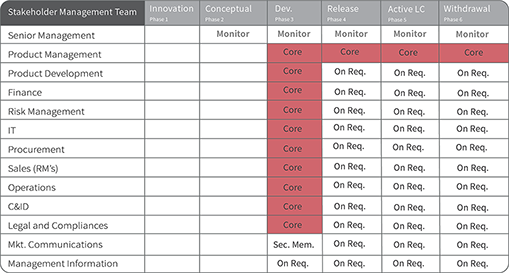

Limit demands on Company resources
The use of small QFD team reduces the threat to business cultures where formal teamwork is unknown and will facilitate discussions and achieving consensus. Efforts should also be made to limit the number and length of meetings.
Selection of team members
The choice of QFD members is fundamental to a projects success. The selection should include the most positive personnel with the closest links to customers. The correct choice will facilitate open discussions, the resolution of conflicts and encourage team commitment to the project.
Recognition by senior management
The choice of senior management in the formulation of a QFD project is important in gaining their commitment to the process and in providing incentives for personnel participation.
Intuitive checks
The results at each stage of a QFD project should be compared with intuitive views of the team members. Where a divergence is noted analysis can be directed at identifying the factors responsible. The appropriate changes can then be made to the matrices or the perceptions of the team.
A flexible approach...
Care must be taken to adapt the approach used to apply the QFD project to the circumstances of the organisation. Eg. Realistic objectives, format of the team, type an complexity of the process.
Limit the functional hierarchical conflicts in the QFD team
For an initial QFD implementation, functional or hierarchical barriers within the team should be limited to minimise disruptive conflicts.
Conflict avoidance
The selection of team members can reduce the negative aspects of conflict in discussions. Another approach is for the team to list all the issues relating to a contentious matrix relationship and assign weightings to each of these before producing an overall weighting. This divides a difficult decision into logical steps and helps to separate individuals from the issues being considered.
Use small matrices
Limiting the size of matrix helps avoid complexity, focuses the team on the most important issues and reduces pressure on resources.
Use sensitive market research...
Be aware of the commercial sensitivity of the information demanded in a standard QFD Project. – Customers may not be willing to report on the performance of competitive products and may develop a low opinion of a Company demanding this information.
Document issues raised...
Record the issues raised during discussions on each matrix interrelationship so at a later date the weighting can be justified drawing upon the reasoning.
Identify key relationships
When completing the interrelationship matrix, initially highlight the key relationships which have the greatest impact on customer satisfaction. Then focus on establishing the issues relevant to these, rather than a time consuming consideration of every matrix cell.
Matrix Analysis
Empty Rows
Demanded quality items with no relating Quality Characteristics means there is no way to assure Demanded Quality will be achieved. Go back to Demanded Quality and define new Quality Characteristics.
Empty Columns
Quality characteristics that do not relate to ‘Demanded’ quality. Unnecessary Quality Characteristics make the matrix cumbersome. Check to be sure these are Quality Characteristics, they relate to the product or service and not the usage environment or the user.
Rows with no Strong Relationships
Demanded Quality is difficult to achieve without at least one strongly related Quality Characteristic. Review both Demanded and Quality Characteristics.
Rows that repeat identical Relationships
Demanded Quality relationships are repeating, indicating a problem with the Demanded Quality hierarchy.
Examine Demanded Quality Classification Hierarchy (Tree) to assure that levels of detail are arranged properly. A common problem is 4th level details being mixed in with 3rd level.
This can cause serious problems later on if this repetition causes some Quality Characteristics to be weighted too heavily.
Clusters of Relationships
Possible hierarchy problems in either Demanded Quality Classification Hierarchy (Tree), Quality Characteristics Hierarchy (Tree) or both. Review and correct possible problem with inappropriate Quality Characteristics.
Row with too many Relationships
Demanded Quality item may actually be a cost, reliability or safety item. Remove from House of Quality for deployment in Reliability Deployment, Cost Deployment or Safety Deployment.
Demanded Quality item may be 1st or 2nd level mixed in with lower levels. Review hierarchy in Demanded Quality Classification Hierarch (Tree).
Column with too many Relationships
Quality Characteristic may actually be a cost, reliability or safety item. Remove from House of Quality for deployment in Reliability Deployment, Cost Deployment or Safety Deployment.
Quality Characteristic may be 1st or 2nd level mixed in with lower levels. Review hierarchy in QC Classification Hierarchy (Tree).
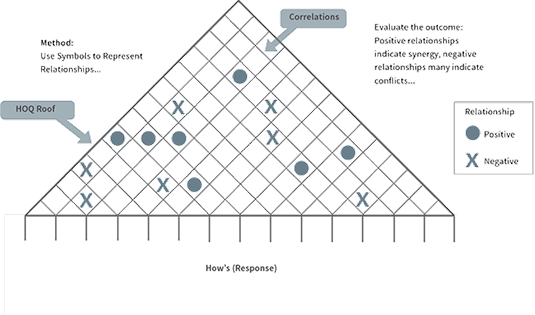
|Do's and Don'ts

|Method
|QFD Project Start-up
|Planning the QFD- Project
|Established a Routine of Briefings and Debriefings for Team Meetings
|Building the house of Quality


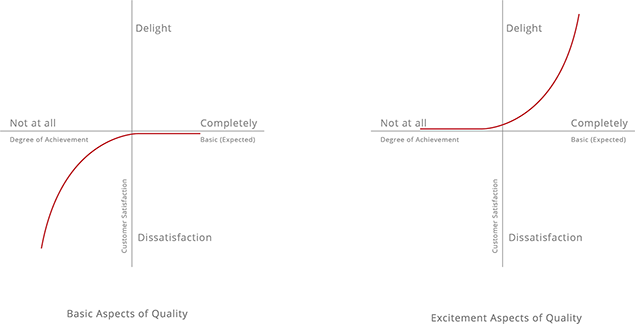


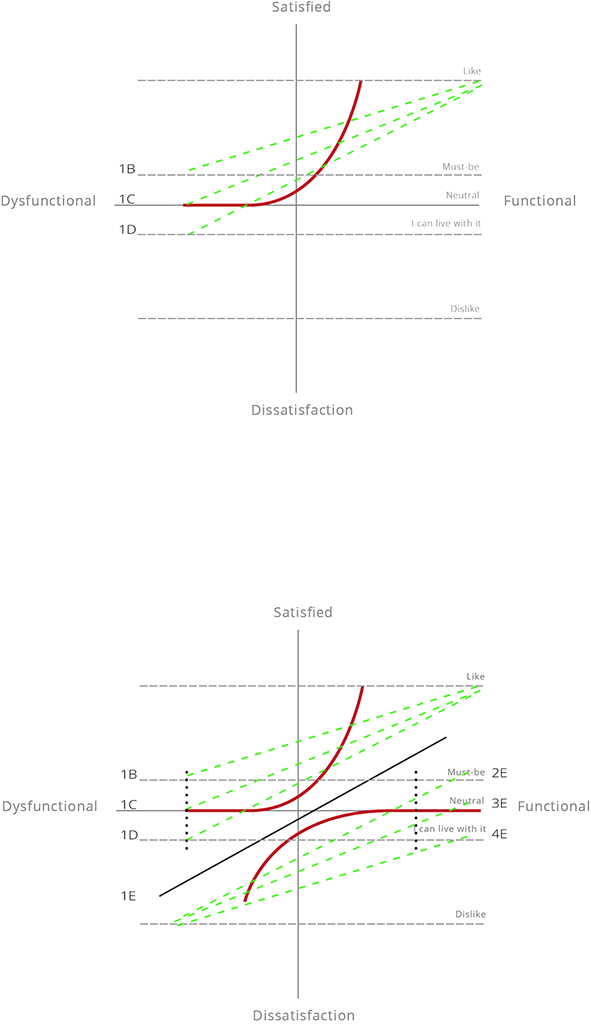
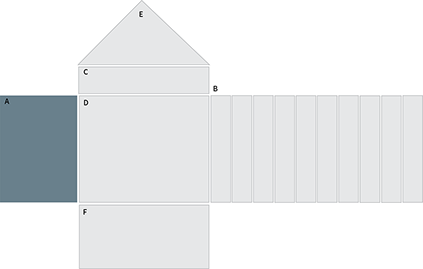

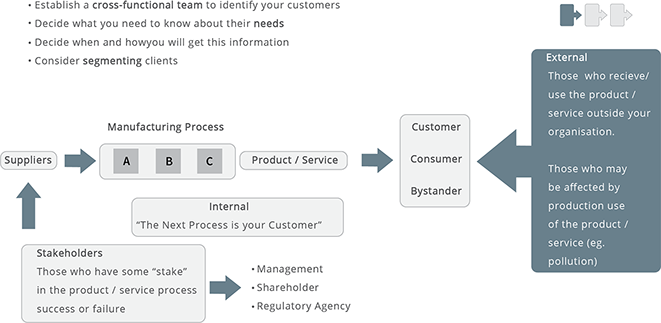
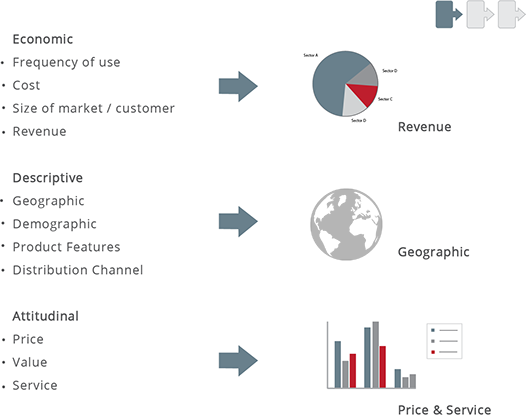
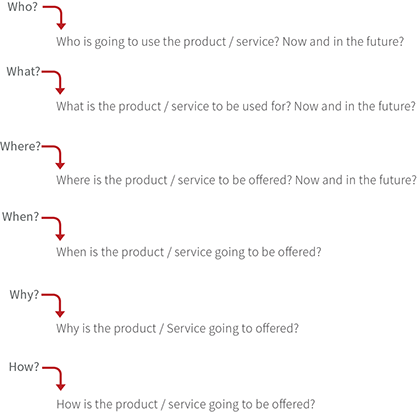


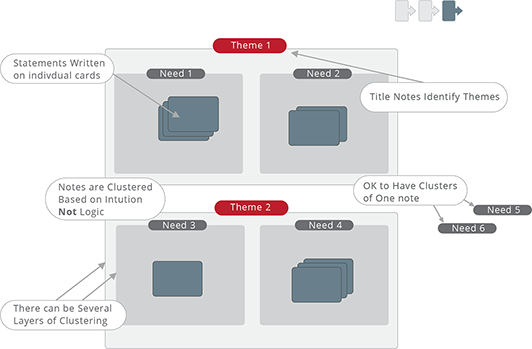
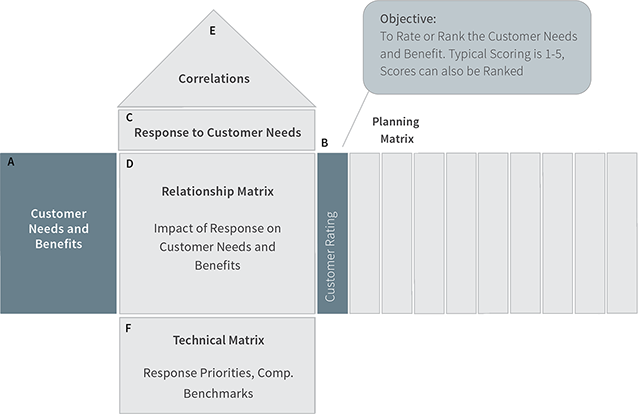

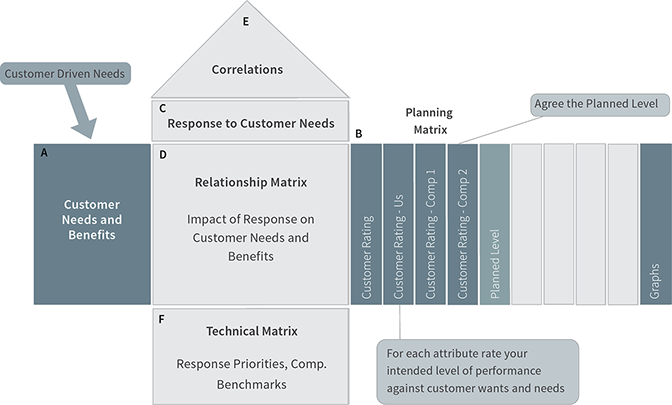
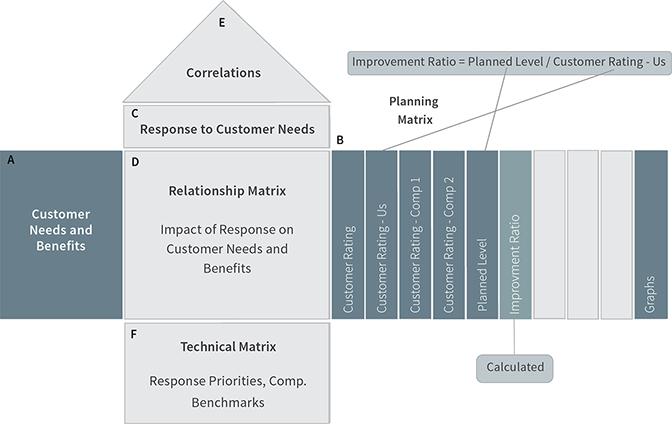

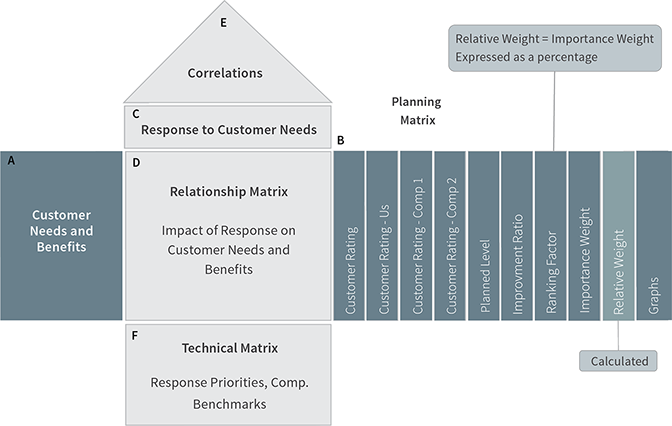


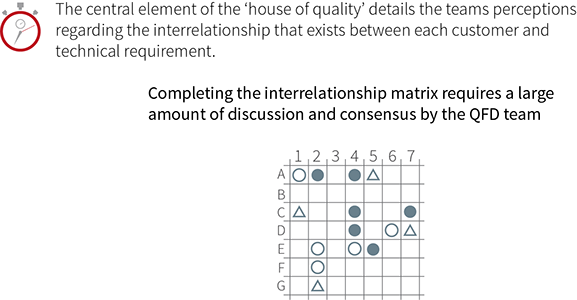
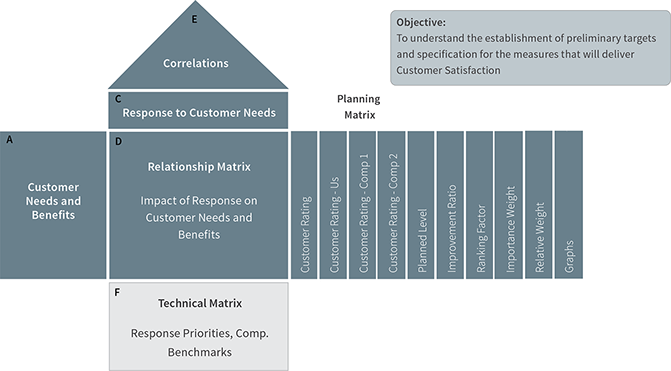
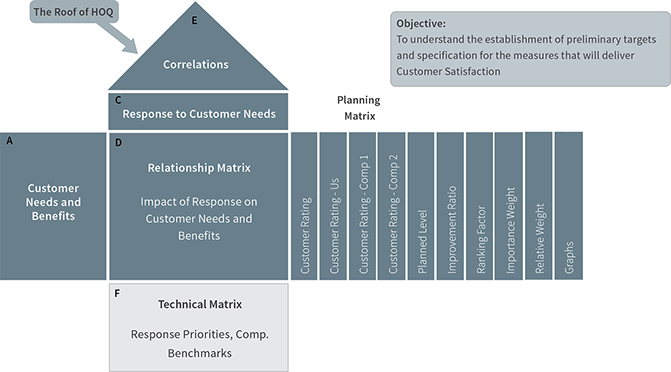

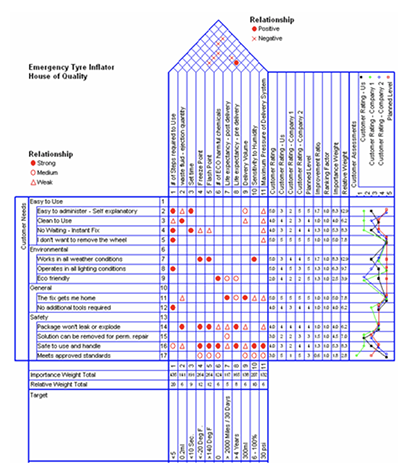

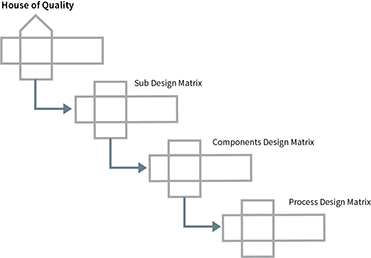

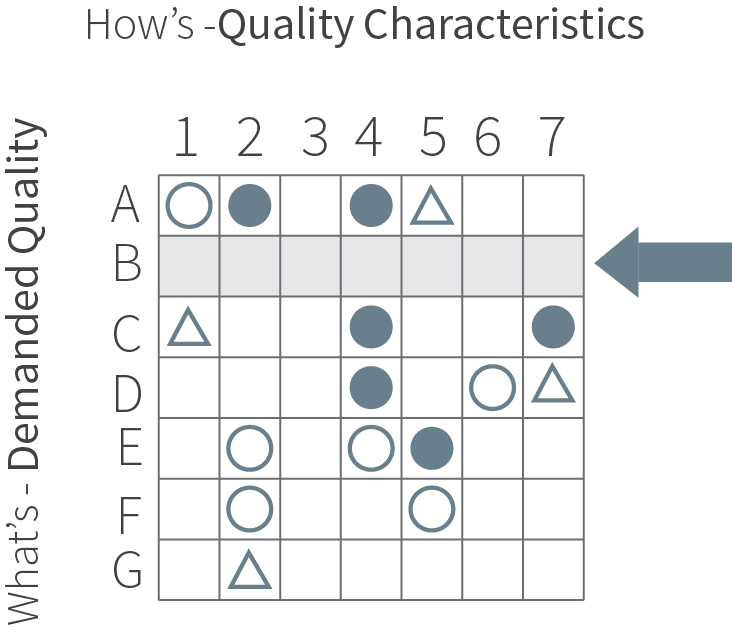
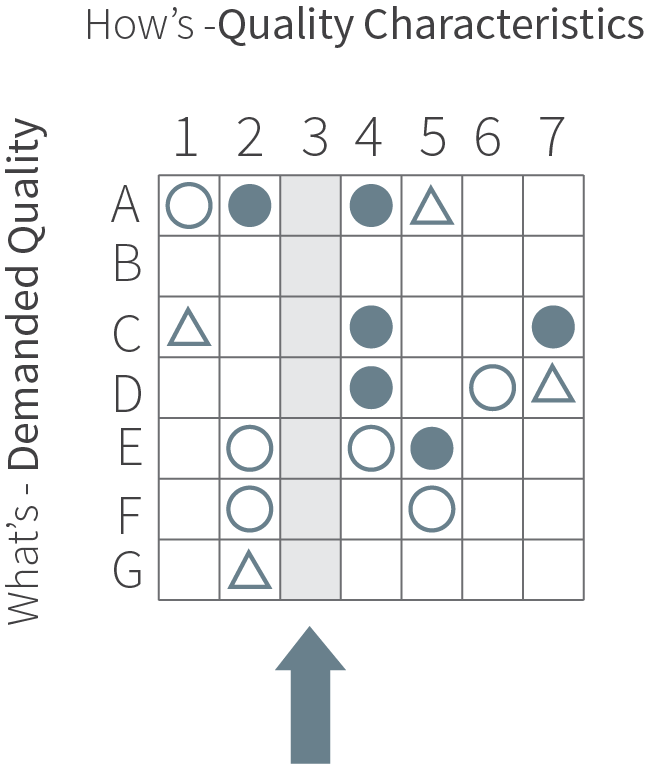


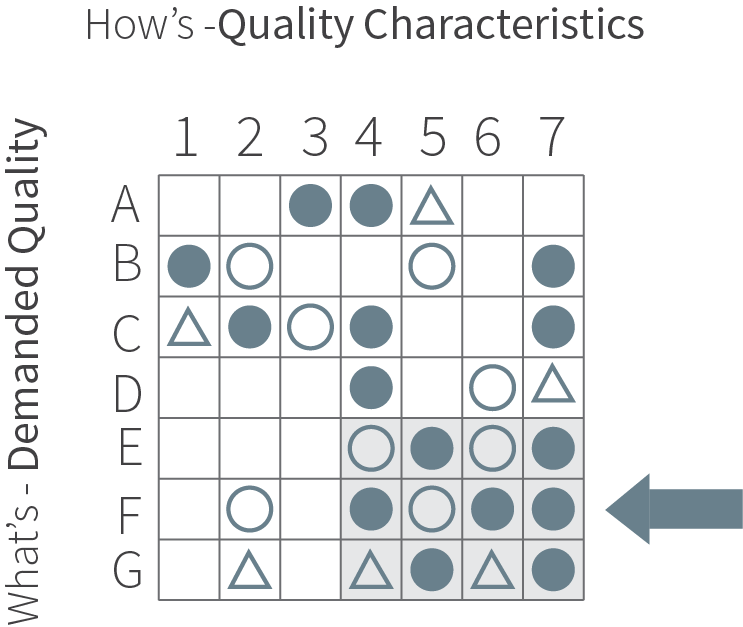
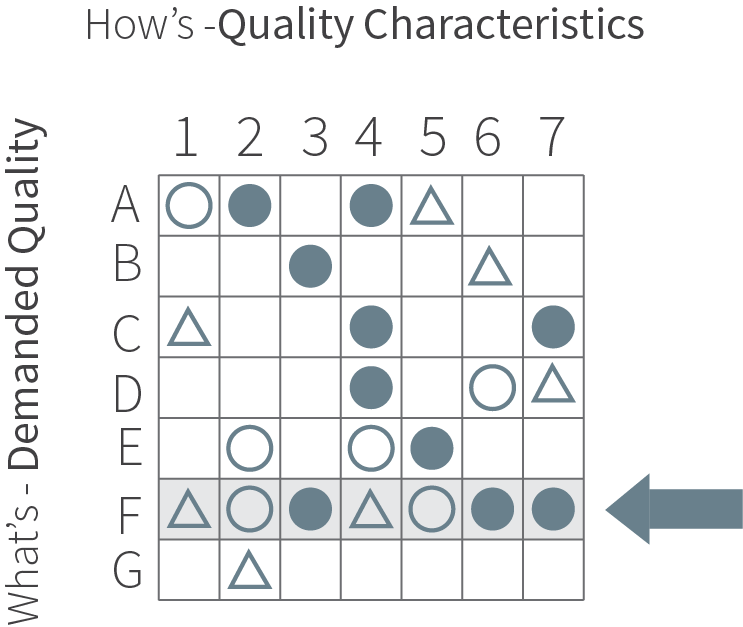
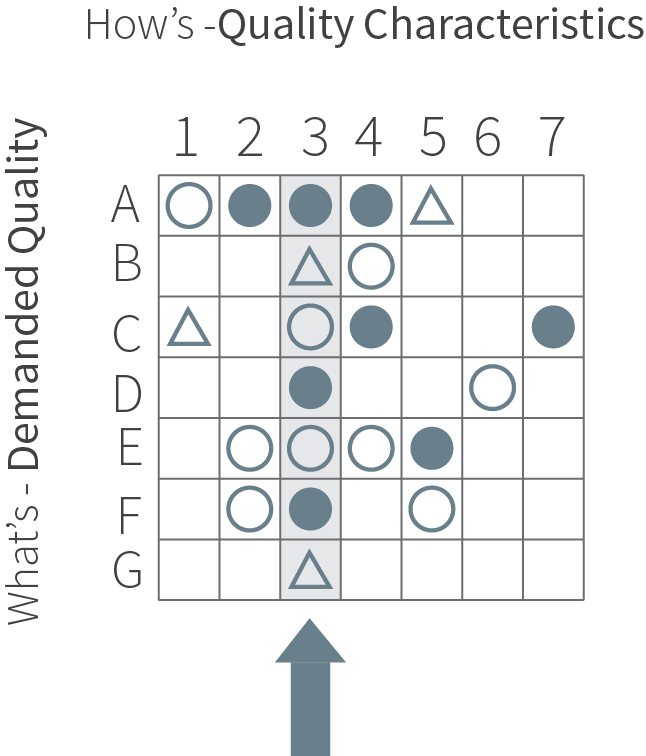
|Related Procedures
The following interrelationship maps indicate; suggested content from other models/processes which may have influence or an effect on the analysis of the title process. The left-hand column indicates information or impact from the named process and the left-hand column indicates on completion of the process/analysis it may have an influence or effect on the listed processes.
Note: A complete set (professional quality) of PMM interrelationship cards are available to purchase - please contact us for further details.
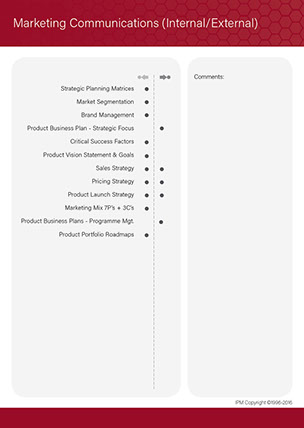
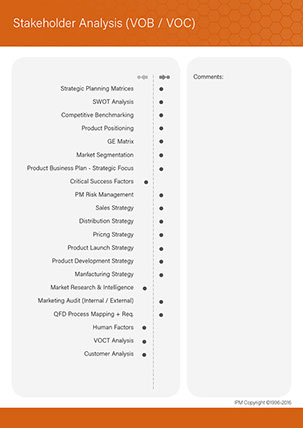
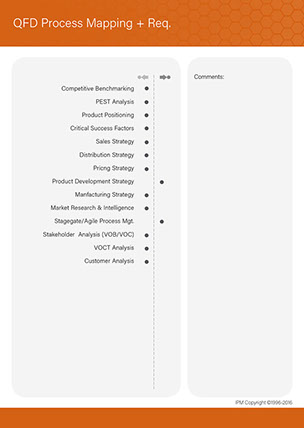
|Strategic Business Models, Workshop Tools & Professional Resources
The IPM practitioner series, is a definitive and integrated training programme for management professionals operating in the Product Management arena. So whether you’re the Managing Director, Product Director, Product Manager or a member of the Multidisciplinary Team we are confident that you will find this particular training series to be one of the best available and an invaluable asset to both you and your company.
PMM - Professional Support
Interactive Business Models
More







